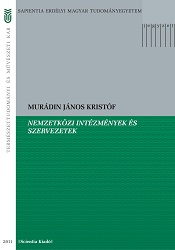Nemzetközi intézmények és szervezetek
International Institutions and Organizations
Author(s): János Kristóf Murádin
Subject(s): Politics / Political Sciences, Public Administration
Published by: Scientia Kiadó
Keywords: international institutions;international organizations;International Monetary Fund;
Summary/Abstract: The aim of the course book entitled International Institutions and Organizations is to offer a guide to students specializing in International Relations and European Studies. First of all, it contains a theoretical introduction to the international institutions and organizations in general, going through the basic characteristics of these actors of international relations. Besides historical antecedents of the formation of international institutions and organizations, the introductory chapter contains the definition and a classification, the membership, budget, the legal subjects and diplomatic status, etc. Following the introduction, the course book is structured into seven main chapters, which present the basic types of intergovernmental institutions and organizations, such as political, military, security, economic, environmental protection, financial, scientific and cultural ones. Each of these chapters describe in detail the main international institutions and organizations of the respective domain, arranged in chronological order according to their date of foundation. The following institutions and organizations are presented: the Commonwealth of Nations, the League of Nations, the United Nations Organization, the Council of Europe, the North Atlantic Treaty Organization, the Warsaw Treaty, the Organization for Security and Cooperation in Europe, the International Labour Organization, the Council for Mutual Economic Assistance, the Organization of the Petroleum Exporting Countries, the Group of Seven (G-7)–Group of Eight (G-8), the Kyoto Protocol, the Bretton Woods system, the International Bank for Reconstruction and Development, the International Monetary Fund, the United Nations Educational, Scientific and Cultural Organization and finally the World Intellectual Property Organization. Besides a short general description, each presentation focuses on the following main aspects: the foundation process, members, headquarters, official languages, organizational structure and activity. These are followed, in each case by a short evaluation referring to the whole institution or organization in question, which offers a surplus to the course book over its encyclopaedic aspect. At the end of the book there is a bibliography and a list of notions that help the students in understanding the material much better. The entire book covers a one-semester course in International Relations and European Studies.
Series: Jegyzetek
- Print-ISBN-13: 978-973-197-059-2
- Page Count: 264
- Publication Year: 2011
- Language: Hungarian
- eBook-PDF
- Sample-PDF
- Table of Content

